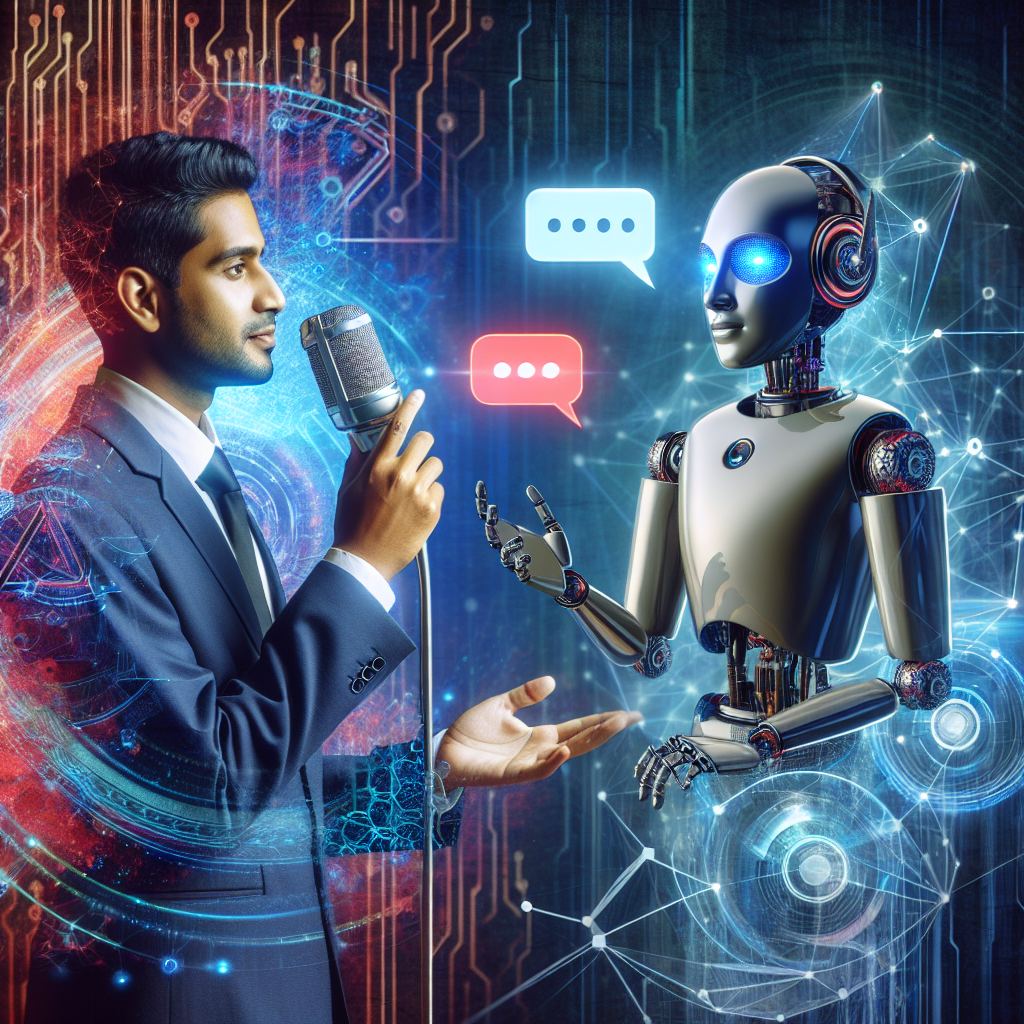Voice And Chatbot Integration
Imagine a world where your virtual assistant not only responds to your voice commands, but also engages in dynamic conversations like a real human being. Voice and chatbot integration is the next frontier in AI technology, revolutionizing the way we interact with our devices. With this groundbreaking integration, you will be able to seamlessly transition from speaking to texting, and vice versa, as the lines between human and machine conversation blur. Get ready to experience a whole new level of convenience and efficiency as your voice and chatbot become one, effortlessly assisting you in all aspects of your daily life.
Advantages of Voice and Chatbot Integration
Enhanced user experience
Voice and chatbot integration offers an enhanced user experience by providing a more fluid and seamless interaction. Users can choose to communicate with the chatbot using either voice or text, depending on their preference, making the interaction more personalized. This integration allows for a more natural conversation flow, which can lead to increased user satisfaction.
Improved accessibility
Voice and chatbot integration opens up new possibilities for users with disabilities or those who prefer voice-based interactions. By incorporating voice recognition technology, individuals with visual impairments or motor disabilities can interact with chatbots more easily. This integration also benefits those who may have difficulty typing or reading, allowing them to access information or services more conveniently.
Increased efficiency and productivity
Integrating voice and chatbot capabilities can greatly improve efficiency and productivity. Voice interactions enable quicker and more hands-free access to information, allowing users to retrieve information or perform tasks more efficiently. Chatbots, on the other hand, can provide instant responses and handle multiple conversations simultaneously, resulting in faster resolution of queries and increased productivity for businesses.
Different Approaches for Voice and Chatbot Integration
Native Integration
Native integration involves embedding voice and chatbot capabilities directly into a platform or application. This approach offers a seamless user experience as the voice and chatbot functionalities are tightly integrated with the platform’s interface. Native integration allows for more control over the user experience and allows businesses to customize the voice and chatbot functionalities according to their specific needs. However, developing and maintaining native integration can be resource-intensive.
Third-party Integration
Third-party integration involves integrating voice and chatbot functionalities from external providers into an existing platform or application. This approach offers the advantage of leveraging the expertise and resources of specialized voice and chatbot providers. Businesses can select from a range of pre-built voice and chatbot solutions that suit their requirements. Third-party integration is often quicker to implement and more cost-effective compared to native integration. However, it may have limitations in terms of customization and flexibility.
API Integration
API integration allows businesses to integrate voice and chatbot functionalities using application programming interfaces (APIs) provided by voice and chatbot service providers. This approach offers flexibility and scalability as businesses can leverage the functionalities of multiple providers or services. API integration allows for easy integration into existing systems and applications, making it a popular choice for businesses looking to add voice and chatbot capabilities. However, it requires developers with API integration expertise and may require ongoing management and maintenance.
Best Practices for Voice and Chatbot Integration
Define clear objectives
Before integrating voice and chatbot capabilities, it is essential to define clear objectives and goals. Determine what specific tasks or functionalities the voice and chatbot should support and how they align with the overall business objectives. Clear objectives help in selecting the appropriate voice and chatbot integration approach and ensure a successful implementation.
Consider user preferences and needs
Understanding the preferences and needs of the target audience is crucial for a successful voice and chatbot integration. Conduct user research, surveys, or interviews to gather insights into the preferred communication channels and the value users expect from the voice and chatbot. Consider factors such as age demographics, customer personas, and cultural differences to provide a personalized experience that caters to the expectations of the users.
Ensure seamless transition between voice and chatbot
A seamless transition between voice and chatbot interactions is essential for a smooth user experience. The transition should be effortless and intuitive, allowing users to switch between voice and text seamlessly. Implementing features such as voice-to-text and text-to-voice conversion ensures a consistent and fluid conversation flow, regardless of the chosen mode of interaction.
Test and optimize the integration
Regular testing and optimization are crucial for ensuring the effectiveness of voice and chatbot integration. Conduct user testing sessions to gather feedback and identify areas for improvement. Use analytics and data-driven insights to analyze user interactions and optimize the voice and chatbot capabilities accordingly. Continuously iterate and refine the integration to enhance the user experience and achieve the desired objectives.
Potential Challenges in Voice and Chatbot Integration
Language and dialect compatibility
Language and dialect compatibility can be a major challenge in voice and chatbot integration. Voice recognition technology may struggle with accents, dialects, or non-standard speech patterns, leading to inaccurate transcriptions or misinterpretation of user inputs. Chatbots may also face challenges in understanding regional variations of language, slang, or colloquialisms. Addressing these challenges requires robust language models and ongoing training to improve recognition accuracy.
Accurate voice recognition
Accurate voice recognition is critical for the success of voice and chatbot integration. Voice recognition technology should be able to accurately transcribe and understand spoken language, even with varying speech patterns and accents. Improving voice recognition accuracy involves training models with diverse datasets, including different languages, accents, and speech variations. Regular updates and advancements in speech recognition algorithms are necessary to ensure high accuracy.
Chatbot understanding natural language
Teaching chatbots to understand and respond to natural language is a complex challenge. Natural language processing (NLP) techniques and machine learning algorithms are used to train chatbots to recognize and interpret user queries. However, chatbots may struggle with ambiguous or context-dependent queries, requiring ongoing training and improvement. Enhancing the chatbot’s understanding of natural language involves continuous training with user interactions and refining the NLP algorithms.
Handling complex interactions
Handling complex interactions can be challenging for both voice and chatbot integration. Chatbots need to be equipped to handle multi-turn conversations, where context and user intents can change throughout the conversation. Voice interactions may involve complex tasks or queries that require extensive backend integration and processing. Designing robust conversational flows and incorporating intelligent dialogue management techniques can help in handling complex interactions effectively.
Use Cases of Voice and Chatbot Integration
Customer support
Voice and chatbot integration can greatly improve customer support experiences. Users can interact with chatbots through voice or text, allowing for quick and efficient issue resolution. Chatbots can provide instant responses to common queries, freeing up customer support agents to focus on more complex issues. Voice interactions offer a more personalized and human-like experience, helping users feel supported and understood.
Sales and marketing
Voice and chatbot integration can enhance sales and marketing efforts by providing personalized recommendations and assistance. Chatbots can engage with potential customers through voice or text interactions, helping them find relevant products or services based on their preferences. Voice interactions can create a more engaging and interactive shopping experience, guiding users through the sales process and providing real-time product information.
Information retrieval
Voice and chatbot integration can greatly improve information retrieval processes. Users can ask questions or make specific requests using their voice, and chatbots can retrieve relevant information and provide accurate responses. Whether it’s searching for specific content, retrieving data from databases, or accessing knowledge bases, voice and chatbot integration offers a more convenient and efficient way to retrieve information.
Personal assistants
Voice and chatbot integration can transform devices or applications into personal assistants that assist users in their daily lives. Users can interact with their devices through voice commands or chatbot conversations to perform tasks such as setting reminders, scheduling appointments, or controlling smart home devices. Integration with internet-of-things (IoT) devices enables voice-controlled automation, making personal assistants a valuable addition to users’ lives.
Future Trends of Voice and Chatbot Integration
Advanced machine learning algorithms
Advancements in machine learning algorithms will play a significant role in the future of voice and chatbot integration. These algorithms will continuously improve voice recognition accuracy, allowing for more accurate transcriptions and interpretations of user commands. Intelligent chatbot models will get better at understanding natural language, leading to more human-like conversations. This will further enhance the user experience and expand the capabilities of voice and chatbot integration.
Emotion recognition and sentiment analysis
Future voice and chatbot integration will incorporate emotion recognition and sentiment analysis capabilities. By analyzing voice tone, facial expressions, or text sentiment, chatbots can detect and respond to user emotions more effectively. This will enable chatbots to provide tailored support, empathetic responses, and personalized recommendations, further enhancing the user experience and building stronger connections with users.
Multilingual and cross-platform support
Multilingual and cross-platform support will become increasingly important in voice and chatbot integration. As businesses expand globally, the ability to understand and respond in multiple languages will be crucial. Voice recognition algorithms will need to handle different accents, dialects, and languages accurately. Integration across multiple platforms and devices, including smartphones, smart speakers, and IoT devices, will ensure a consistent voice and chatbot experience across various touchpoints.
Examples of Successful Voice and Chatbot Integration
Google Assistant
Google Assistant is a prime example of successful voice and chatbot integration. It offers voice-based interactions through smartphones, smart speakers, and other devices. Users can ask questions, perform tasks, and access a wide range of Google services using natural language voice commands. Google Assistant utilizes advanced machine learning algorithms for accurate voice recognition and natural language understanding, providing a seamless and intuitive experience.
Amazon Alexa
Amazon Alexa is another notable example of successful voice and chatbot integration. Alexa powers Amazon’s Echo devices and offers voice-based assistance in various areas, including home automation, shopping, and entertainment. Users can interact with Alexa using voice commands to control smart home devices, play music, order products, and access information. Alexa’s integration across devices and services has made it a popular choice for users seeking a voice-powered personal assistant.
Microsoft Cortana
Microsoft Cortana is a voice and chatbot integration that combines natural language processing and personalized assistance. Cortana is integrated into Microsoft’s Windows operating system and provides voice-based interactions with various Microsoft services and applications. Users can ask questions, set reminders, compose emails, or control their devices using voice commands. Cortana’s ability to understand context and personalize responses enhances the user experience.
IBM Watson
IBM Watson is an advanced cognitive chatbot and voice integration platform. It combines natural language understanding, machine learning, and data analytics to provide intelligent voice and chatbot interactions. Watson’s capabilities range from answering complex questions and analyzing vast amounts of data to providing personalized recommendations and insights. IBM Watson’s integration capabilities make it a powerful tool for businesses across various industries.
Security and Privacy Considerations in Voice and Chatbot Integration
Data encryption and storage
Ensuring data encryption and secure storage is essential in voice and chatbot integration. Voice interactions may involve sensitive information, such as personal details or financial data. Implementing strong encryption protocols and secure storage practices safeguards user information from unauthorized access or breaches.
User consent and data protection
Respecting user privacy and obtaining proper consent is critical in voice and chatbot integration. Clearly communicate and seek user consent for data collection and usage. Implement proper data protection measures to safeguard user information and adhere to relevant data protection regulations.
Secure authentication and authorization
Implementing secure authentication and authorization mechanisms is crucial in voice and chatbot integration. Voice interactions may involve accessing sensitive data or performing actions on behalf of users. Robust authentication protocols, such as voice biometrics or two-factor authentication, ensure that only authorized users can access and interact with the voice and chatbot functionalities.
Ethical Implications of Voice and Chatbot Integration
User privacy and data collection
Voice and chatbot integration raises ethical concerns regarding user privacy and data collection. Businesses must be transparent about the information collected and how it will be used. Implementing privacy policies and data protection practices that prioritize user consent and control over their data addresses these concerns and builds trust with users.
Responsibility in bot behavior and decisions
Chatbots should be designed with responsible and ethical behavior. Ensuring that chatbots adhere to ethical guidelines, respect user boundaries, and avoid biases and discrimination is essential. Regular monitoring and auditing of chatbot interactions help in identifying and addressing any ethical issues that may arise.
The Role of Artificial Intelligence in Voice and Chatbot Integration
Natural Language Processing
Artificial intelligence plays a significant role in voice and chatbot integration, particularly in natural language processing (NLP). NLP allows chatbots to understand and interpret user queries and respond in a human-like manner. Machine learning algorithms and deep learning techniques enable chatbots to continuously improve their understanding of natural language and provide accurate responses.
Speech recognition and synthesis
Artificial intelligence enables advanced speech recognition and synthesis capabilities in voice and chatbot integration. Automatic speech recognition (ASR) technology converts spoken language into written text, while text-to-speech synthesis (TTS) technology converts written text into natural-sounding speech. AI-powered algorithms and models enhance the accuracy and quality of speech recognition and synthesis, creating more interactive and engaging voice interactions.
Machine learning algorithms
Machine learning algorithms underpin many aspects of voice and chatbot integration. These algorithms learn from user interactions, enabling chatbots to improve their understanding, responses, and decision-making over time. Machine learning algorithms also contribute to voice recognition accuracy, helping chatbots accurately transcribe and comprehend user voice commands.
In conclusion, voice and chatbot integration offers numerous advantages, including enhanced user experience, improved accessibility, and increased efficiency and productivity. Different approaches, such as native integration, third-party integration, and API integration, provide flexibility and scalability. Best practices, including defining clear objectives, considering user preferences, ensuring seamless transitions, and testing and optimizing integration, contribute to successful implementations. Challenges, such as language compatibility, accurate voice recognition, natural language understanding, and handling complex interactions, can be addressed through advanced technologies and ongoing improvement. Voice and chatbot integration has use cases in customer support, sales and marketing, information retrieval, and personal assistants. Future trends include advanced machine learning algorithms, emotion recognition, sentiment analysis, and multilingual and cross-platform support. Successful examples of voice and chatbot integration include Google Assistant, Amazon Alexa, Microsoft Cortana, and IBM Watson. Security and privacy considerations, ethical implications, and the role of artificial intelligence need to be addressed in voice and chatbot integration. By embracing the potential of voice and chatbot integration and adhering to best practices and ethical guidelines, businesses can create innovative and valuable experiences for their users.





